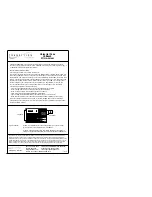
Page 25
HUGO SACHS ELEKTRONIK - HARVARD
A P P A R A T U S
GmbH D-79232 March-Hugstetten Germany
HSE PLUGSYS
®
TAM-A Type 705/1 and TAM-D Type 705/2
Back to our example with a range up to 10g.
The TAM amplifier has an output voltage of +- 10V.
0% deflection is equal to 0V, 100% deflection on the bargraph is equal to 10V.
If we now intend to measure up to 10g we have to set the GAIN so that we reach 10V
(100%) for 10g or 5V (50%) for 5g.
•
set switch CAL/OFF/MEASURE in MEASURE position
•
attach a calibration weight of e.g. 5g to your transducer
•
now look to the bargraph and check the deflection
•
adjust the GAIN trimmer on the front panel with the little red screwdriver, which was
delivered with the system
•
adjust GAIN so that you get 5V (50% bargraph deflection) for 5g. The output delivers the voltage of 5V.
•
remove the calibration weight from your force transducer, you should get 0V on the output
•
now hang 1g weight to the transducer, you should receive 1V on the output
•
add an other gram and you should receive 2V on the output
•
if this is the case all is set well. If not readjust.
In order to avoid performing a full calibration of the output to your DAQ system daily, you
can set the module so that it simulates a value of 1g or 5g in position CAL.
•
Set switch CAL/OFF/MEASURE into CAL position. This simulates a force on the
bargraph and on the output socket of the module.
•
Take the little red screwdriver and turn on the CAL trimmer (not on the GAIN !) so
that you get +1V (10% bargraph deflection) which is equal to 1g.
Now all settings are done and you can switch back the module to MEASURE position and
start your measurements.
•
If you e.g need more accuracy but less range you can increase the GAIN e.g. by a
factor of 2. (1g = 2V, Range will be halfed then)
•
attach a calibration weight of e.g. 1g
•
now look to the bargraph and check the deflection
•
adjust the GAIN trimmer on the front panel with the little red screwdriver, which was
delivered with the system
•
adjust GAIN so that you get 2V (20% bargraph deflection) for 1g. The output deliv-
ers the voltage of 2V.
•
remove weight from your force transducer, you should get 0V on the output
•
again hang 2g to the transducer, you should receive 2V on the output
•
add an other gram and you should receive 3V on the output
•
if this is the case all is set well. If not readjust.
Remember that if you use a force transducer to measure the tension of an isolated muscle prepara-
tion, all tissues require a preload. The preload is part of the measurement signal and must be
included in the measurement range when you select it.
You may have a tissue which requires 1000mg of preload to develop a contractile force of 200mg. In
that case you can not select a range of 500mg which would easily cover the contractile force,
therefore you must select a range of 2000mg which covers preload and contractile force added on.
Important

































